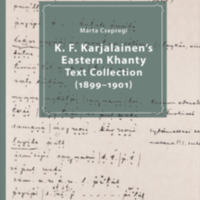Suomalais-Ugrilainen Seura eli SUS on yksi Suomen vanhimmista ja suurimmista tieteellisistä seuroista. Perustamisestaan lähtien (1883) seura on pyrkinyt edistämään uralilaisten ja altailaisten kielten ja näitä kieliä puhuvien kansojen kulttuurien, kansatieteen, kansanrunouden ja esihistorian tutkimusta. Seuran toiminta painottuu alan tutkimusten julkaisemiseen. Lisäksi vuosittain pidetään yhdeksän kokousta, joiden yhteydessä kuullaan seuran toimialaan liittyviä tieteellisiä esitelmiä. Suomalais-Ugrilainen Seura myös tukee stipendein ja apurahoin seuran työaloihin liittyvää tieteellistä tutkimusta ja keruuta. Sen arkisto ja kokoelmat ovat tutkijoiden käytettävissä.
Seuran teoksia myy kirjakauppa Tiedekirja.
Seuraa Suomalais-Ugrilaista Seuraa Facebookissa, Instagramissa ja X:ssä!
Uusin julkaisu
K. F. Karjalainen’s Eastern Khanty Text Collection (1899–1901) (SUST 279)

During fieldwork conducted between 1898 and 1902 in Western Siberia, Kustaa Fredrik Karjalainen traveled through the entire area where Khanty (also…
